Storm-Driven Geomorphological Changes on a Mediterranean Beach: High-Resolution UAV Monitoring and Advanced GIS Analysis
Abstract
1. Introduction
2. Study Area
3. Materials and Methods
3.1. Topographic Surveys and Morphological Analysis
3.2. Meteo-Oceanographic Data: RON Buoy and ERA5 Reanalysis
- SHWW ≥ 5.01 m;
- U10 ≥ 12.95 m/s;
- MSL ≤ 985.18 hPa.
4. Results
4.1. Description of the Meteorological Event
4.2. Geomorphological Effects
5. Discussion
6. Conclusions
Funding
Data Availability Statement
Conflicts of Interest
References
- Zhang, K.; Douglas, B.C.; Leatherman, S.P. Global Warming and Coastal Erosion. Clim. Change 2004, 64, 41–58. [Google Scholar] [CrossRef]
- Giorgi, F. Climate Change Hot-Spots. Geophys. Res. Lett. 2006, 33, L08707. [Google Scholar] [CrossRef]
- Tuel, A.; Eltahir, E.A.B. Why Is the Mediterranean a Climate Change Hot Spot? J. Clim. 2020, 33, 5829–5843. [Google Scholar] [CrossRef]
- Lazoglou, G.; Papadopoulos-Zachos, A.; Georgiades, P.; Zittis, G.; Velikou, K.; Manios, E.M.; Anagnostopoulou, C. Identification of Climate Change Hotspots in the Mediterranean. Sci. Rep. 2024, 14, 29817. [Google Scholar] [CrossRef] [PubMed]
- Besset, M.; Anthony, E.J.; Bouchette, F. Multi-Decadal Variations in Delta Shorelines and Their Relationship to River Sediment Supply: An Assessment and Review. Earth Sci. Rev. 2019, 193, 199–219. [Google Scholar] [CrossRef]
- Pranzini, E.; Anfuso, G.; Cinelli, I.; Piccardi, M.; Vitale, G. Shore Protection Structures Increase and Evolution on the Northern Tuscany Coast (Italy): Influence of Tourism Industry. Water 2018, 10, 1647. [Google Scholar] [CrossRef]
- Rangel-Buitrago, N.; Williams, A.T.; Anfuso, G. Hard Protection Structures as a Principal Coastal Erosion Management Strategy along the Caribbean Coast of Colombia. A Chronicle of Pitfalls. Ocean. Coast Manag. 2018, 156, 58–75. [Google Scholar] [CrossRef]
- Bertoni, D.; Bini, M.; Luppichini, M.; Cipriani, L.E.; Carli, A.; Sarti, G. Anthropogenic Impact on Beach Heterogeneity within a Littoral Cell (Northern Tuscany, Italy). J. Mar. Sci. Eng. 2021, 9, 1–22. [Google Scholar] [CrossRef]
- Toimil, A.; Camus, P.; Losada, I.J.; Le Cozannet, G.; Nicholls, R.J.; Idier, D.; Maspataud, A. Climate Change-Driven Coastal Erosion Modelling in Temperate Sandy Beaches: Methods and Uncertainty Treatment. Earth Sci. Rev. 2020, 202, 103110. [Google Scholar] [CrossRef]
- Anthony, E.J.; Marriner, N.; Morhange, C. Human Influence and the Changing Geomorphology of Mediterranean Deltas and Coasts over the Last 6000years: From Progradation to Destruction Phase? Earth Sci. Rev. 2014, 139, 336–361. [Google Scholar] [CrossRef]
- Williams, A.T.; Rangel-Buitrago, N.; Pranzini, E.; Anfuso, G. The Management of Coastal Erosion. Ocean. Coast Manag. 2018, 156, 4–20. [Google Scholar] [CrossRef]
- Calvin, K.; Dasgupta, D.; Krinner, G.; Mukherji, A.; Thorne, P.W.; Trisos, C.; Romero, J.; Aldunce, P.; Barrett, K.; Blanco, G.; et al. IPCC, 2023: Climate Change 2023: Synthesis Report. Contribution of Working Groups I, II and III to the Sixth Assessment Report of the Intergovernmental Panel on Climate Change; Core Writing Team, Lee, H., Romero, J., Eds.; IPCC: Geneva, Switzerland, 2023. [Google Scholar]
- Aiello, A.; Canora, F.; Pasquariello, G.; Spilotro, G. Shoreline Variations and Coastal Dynamics: A Space–Time Data Analysis of the Jonian Littoral, Italy. Estuar. Coast. Shelf Sci. 2013, 129, 124–135. [Google Scholar] [CrossRef]
- Manca, E.; Pascucci, V.; Deluca, M.; Cossu, A.; Andreucci, S. Shoreline Evolution Related to Coastal Development of a Managed Beach in Alghero, Sardinia, Italy. Ocean. Coast Manag. 2013, 85, 65–76. [Google Scholar] [CrossRef]
- Alberico, I.; Amato, V.; Aucelli, P.; Paola, G.; Pappone, G.; Rosskopf, C. Historical and Recent Changes of the Sele River Coastal Plain (Southern Italy): Natural Variations and Human Pressures. Rend. Lincei 2012, 23, 3–12. [Google Scholar] [CrossRef]
- Rosskopf, C.M.; Di Paola, G.; Atkinson, D.E.; Rodríguez, G.; Walker, I.J. Recent Shoreline Evolution and Beach Erosion along the Central Adriatic Coast of Italy: The Case of Molise Region. J. Coast. Conserv. 2018, 22, 879–895. [Google Scholar] [CrossRef]
- Borzì, L.; Anfuso, G.; Manno, G.; Distefano, S.; Urso, S.; Chiarella, D.; Di Stefano, A. Shoreline Evolution and Environmental Changes at the NW Area of the Gulf of Gela (Sicily, Italy). Land 2021, 10, 1034. [Google Scholar] [CrossRef]
- Laksono, F.A.T.; Borzì, L.; Distefano, S.; Di Stefano, A.; Kovács, J. Shoreline Prediction Modelling as a Base Tool for Coastal Management: The Catania Plain Case Study (Italy). J. Mar. Sci. Eng. 2022, 10, 1988. [Google Scholar] [CrossRef]
- Lapietra, I.; Lisco, S.; Mastronuzzi, G.; Milli, S.; Pierri, C.; Sabatier, F.; Scardino, G.; Moretti, M. Morpho-Sedimentary Dynamics of Torre Guaceto Beach (Southern Adriatic Sea, Italy). J. Earth Syst. Sci. 2022, 131, 64. [Google Scholar] [CrossRef]
- Celata, F.; Gioia, E. Resist or Retreat? Beach Erosion and the Climate Crisis in Italy: Scenarios, Impacts and Challenges. Appl. Geogr. 2024, 169, 103335. [Google Scholar] [CrossRef]
- Luppichini, M.; Bini, M. 40-Year Shoreline Evolution in Italy: Critical Challenges in River Delta Regions. Estuar. Coast. Shelf Sci. 2025, 315, 109166. [Google Scholar] [CrossRef]
- Billi, P.; Rinaldi, M. Human Impact on Sediment Yield and Channel Dynamics in the Arno River (Central Italy). IAHS Publ.-Ser. Proc. Rep.-Intern Assoc Hydrol. Sci. 1997, 245, 301. [Google Scholar]
- Rinaldi, M. Recent Channel Adjustments in Alluvial Rivers of Tuscany, Central Italy. Earth Surf. Process. Landf. J. Br. Geomorphol. Res. Group 2003, 28, 587–608. [Google Scholar] [CrossRef]
- Surian, N.; Rinaldi, M. Channel Adjustments in Response to Human Alteration of Sediment Fluxes: Examples from Italian Rivers. IAHS Publ. 2004, 288, 276–282. [Google Scholar]
- Surian, N.; Rinaldi, M.; Pellegrini, L.; Audisio, C.; Maraga, F.; Teruggi, L.; Turitto, O.; Ziliani, L. Channel Adjustments in Northern and Central Italy over the Last 200 Years. Spec. Pap. Geol. Soc. Am. 2009, 451, 83–95. [Google Scholar] [CrossRef]
- Bini, M.; Casarosa, N.; Luppichini, M. Exploring the Relationship between River Discharge and Coastal Erosion: An Integrated Approach Applied to the Pisa Coastal Plain (Italy). Remote Sens. 2021, 13, 226. [Google Scholar] [CrossRef]
- Luppichini, M.; Lazzarotti, M.; Bini, M. Climate Change as Main Driver of Centennial Decline in River Sediment Transport across the Mediterranean Region. J. Hydrol. 2024, 636, 131266. [Google Scholar] [CrossRef]
- Cipriani, L.E.; Ferri, S.; Iannotta, P.; Paolieri, F.; Pranzini, E. Morfologia e Dinamica Dei Sedimenti Del Litorale Della Toscana Settentrionale. Studi Costieri 2001, 4, 119–156. [Google Scholar]
- Bini, M.; Casarosa, N.; Ribolini, A. L’evoluzione Diacronica Della Linea Di Riva Del Litorale Pisano (1938-2004) Sulla Base Del Confront Di Immagini Aeree Georeferenziate. Atti Della Soc. Toscana Di Sci. Nat. Mem. Ser. A 2008, 113, 1–12. [Google Scholar]
- Anfuso, G.; Pranzini, E.; Vitale, G. An Integrated Approach to Coastal Erosion Problems in Northern Tuscany (Italy): Littoral Morphological Evolution and Cell Distribution. Geomorphology 2011, 129, 204–214. [Google Scholar] [CrossRef]
- Gonçalves, J.A.; Henriques, R. UAV Photogrammetry for Topographic Monitoring of Coastal Areas. ISPRS J. Photogramm. Remote Sens. 2015, 104, 101–111. [Google Scholar] [CrossRef]
- Turner, I.L.; Harley, M.D.; Drummond, C.D. UAVs for Coastal Surveying. Coast. Eng. 2016, 114, 19–24. [Google Scholar] [CrossRef]
- Taddia, Y.; Corbau, C.; Zambello, E.; Pellegrinelli, A. UAVs for Structure-From-Motion Coastal Monitoring: A Case Study to Assess the Evolution of Embryo Dunes over a Two-Year Time Frame in the Po River Delta, Italy. Sensors 2019, 19, 1717. [Google Scholar] [CrossRef]
- Scicchitano, G.; Scardino, G.; Tarascio, S.; Monaco, C.; Barracane, G.; Locuratolo, G.; Milella, M.; Piscitelli, A.; Mazza, G.; Mastronuzzi, G. The First Video Witness of Coastal Boulder Displacements Recorded during the Impact of Medicane “Zorbas” on Southeastern Sicily. Water 2020, 12, 1497. [Google Scholar] [CrossRef]
- Rizzo, A.; De Giosa, F.; Donadio, C.; Scardino, G.; Scicchitano, G.; Terracciano, S.; Mastronuzzi, G. Morpho-Bathymetric Acoustic Surveys as a Tool for Mapping Traces of Anthropogenic Activities on the Seafloor: The Case Study of the Taranto Area, Southern Italy. Mar. Pollut. Bull. 2022, 185, 114314. [Google Scholar] [CrossRef]
- Novais, J.; Vieira, A.; Bento-Gonçalves, A.; Silva, S.; Folharini, S.; Marques, T. The Use of UAVs for Morphological Coastal Change Monitoring—A Bibliometric Analysis. Drones 2023, 7, 629. [Google Scholar] [CrossRef]
- Sabato, G.; Scardino, G.; Kushabaha, A.; Casagrande, G.; Chirivì, M.; Fontolan, G.; Fracaros, S.; Luparelli, A.; Spadotto, S.; Scicchitano, G. Remote Measurement of Tide and Surge Using a Deep Learning System with Surveillance Camera Images. Water 2024, 16, 1365. [Google Scholar] [CrossRef]
- Luppichini, M.; Bini, M.; Paterni, M.; Berton, A.; Merlino, S. A New Beach Topography-Based Method for Shoreline Identification. Water 2020, 12, 1–11. [Google Scholar] [CrossRef]
- Chen, Z.; Muller-Karger, F.E.; Hu, C. Remote Sensing of Water Clarity in Tampa Bay. Remote Sens. Environ. 2007, 109, 249–259. [Google Scholar] [CrossRef]
- Jiang, L.; Yan, X.; Klemas, V. Remote Sensing for the Identification of Coastal Plumes: Case Studies of Delaware Bay. Int. J. Remote Sens. 2009, 30, 2033–2048. [Google Scholar] [CrossRef]
- Klemas, V. Remote Sensing of Coastal Plumes and Ocean Fronts: Overview and Case Study. J. Coast Res. 2012, 28, 1–7. [Google Scholar] [CrossRef]
- Papakonstantinou, A.; Topouzelis, K.; Pavlogeorgatos, G. Coastline Change Detection Using UAV, Remote Sensing, GIS and 3D Reconstruction. In Proceedings of the Planning and Economics (CEMEPE 2015) and SECOTOX Conference, Mykonos Island, Greece, 14–18 June 2015. [Google Scholar]
- Nunziata, F.; Buono, A.; Migliaccio, M.; Benassai, G.; Di Luccio, D. Shoreline Erosion of Microtidal Beaches Examined with UAV and Remote Sensing Techniques. In Proceedings of the 2018 IEEE International Workshop on Metrology for the Sea; Learning to Measure Sea Health Parameters (MetroSea), Bari, Italy, 08–10 October 2018; IEEE: New York, NY, USA, 2018. [Google Scholar] [CrossRef]
- Vos, K.; Splinter, K.D.; Harley, M.D.; Simmons, J.A.; Turner, I.L. CoastSat: A Google Earth Engine-Enabled Python Toolkit to Extract Shorelines from Publicly Available Satellite Imagery. Environmental Model. Softw. 2019, 122, 104528. [Google Scholar] [CrossRef]
- Vos, K.; Harley, M.D.; Splinter, K.D.; Simmons, J.A.; Turner, I.L. Sub-Annual to Multi-Decadal Shoreline Variability from Publicly Available Satellite Imagery. Coast. Eng. 2019, 150, 160–174. [Google Scholar] [CrossRef]
- Gonçalves, D.; Gonçalves, G.; Pérez-Alvávez, J.A.; Andriolo, U. On the 3D Reconstruction of Coastal Structures by Unmanned Aerial Systems with Onboard Global Navigation Satellite System and Real-Time Kinematics and Terrestrial Laser Scanning. Remote Sens. 2022, 14, 1485. [Google Scholar] [CrossRef]
- Scicchitano, G.; Scardino, G.; Monaco, C.; Piscitelli, A.; Milella, M.; De Giosa, F.; Mastronuzzi, G. Comparing Impact Effects of Common Storms and Medicanes along the Coast of South-Eastern Sicily. Mar. Geol. 2021, 439, 106556. [Google Scholar] [CrossRef]
- Mentaschi, L.; Vousdoukas, M.I.; Pekel, J.-F.; Voukouvalas, E.; Feyen, L. Global Long-Term Observations of Coastal Erosion and Accretion. Sci. Rep. 2018, 8, 12876. [Google Scholar] [CrossRef] [PubMed]
- Scardino, G.; Kushabaha, A.; Sabato, G.; Tarascio, S.; Scicchitano, G. Assessment of Medicane Helios Meteo-Marine Parameters Using a Machine Learning Approach. In Proceedings of the 2023 IEEE International Workshop on Metrology for the Sea; Learning to Measure Sea Health Parameters, MetroSea 2023, La Valletta, Malta, 4–6 October 2023; IEEE: New York, NY, USA, 2023; pp. 508–512. [Google Scholar]
- Federici, P.R.; Mazzanti, R. Note Sulle Pianure Costiere Della Toscana; Italiana, S.G., Ed.; Società Geografica Italiana: Roma, Italy, 1993. [Google Scholar]
- Mazzanti, R. La Pianura Pisana e i Rilievi Contermini; Società Geografica Italiana: Roma, Italy, 1994. [Google Scholar]
- Sarti, G.; Bini, M.; Giacomelli, S. The Growth and the Decline of Pisa (Tuscany, Italy) up to the Middle Ages: Correlations with Landscape and Geology. Quat. Ital. J. Quat. Sci. 2010, 23, 311–322. [Google Scholar]
- Sarti, G.; Bertoni, D.; Bini, M. Integrating Different Databases to Offer a Geological Perspective of Coastal Management: A Review Case from the Northern Tuscany Littoral Cell (Italy). J. Mar. Sci. Eng. 2022, 10, 353. [Google Scholar] [CrossRef]
- Toniolo, A.R. Le Variazioni Storiche Del Litorale Toscano Fra l’Arno e Il Magra. In Proceedings of the Atti del X Congresso Geografico Italiano, Milan, Italy, 1 January 1927. [Google Scholar]
- Toniolo, A.R. Sulle Variazioni Di Spiaggia a Foce d’Arno (Marina Di Pisa) Dalla Fine Del Secolo XViii Ai Nostri Giorni: Studio Storico Fisiografico; di Pisa, C., Ed.; Tipografia Municipale: Pisa, Italy, 1910. [Google Scholar]
- Borgh, L. Apporto Allo Studio Sulle Cause Di Variazione Del Litorale Pisano; Topografia Comunale: Pisa, Italy, 1970. [Google Scholar]
- Palla, B. Variazioni Della Linea Di Riva Tra i Fiumi Arno e Serchio (Tenuta Di S. Rossore—Pisa) Dal 1878 al 1981. Atti Soc. Tosc. Sci. Nat., Mem. Serie A 1983, 90, 125–149. [Google Scholar]
- Bartolini, C.; Pranzini, E. Tracing Nearshore Bottom Currents with Sea-Bed Drifters. Mar. Geol. 1977, 23, 275–284. [Google Scholar] [CrossRef]
- Luppichini, M.; Paterni, M.; Berton, A.; Casarosa, N.; Bini, M. Influences of the Ground Control Point (GCP) Configuration on the UAV-Derived Structure from Motion (SfM) in the Coastal Environment. Earth Sci. Inform. 2025, 18, 144. [Google Scholar] [CrossRef]
- Lionello, P.; Özsoy, E.; Planton, S.; Zanchetta, G. Climate Variability and Change in the Mediterranean Region. Glob. Planet. Change 2017, 151, 1–3. [Google Scholar] [CrossRef]
- Masselink, G.; Puleo, J.A. Swash-Zone Morphodynamics. Cont. Shelf Res. 2006, 26, 661–680. [Google Scholar] [CrossRef]
- Eichentopf, S.; Karunarathna, H.; Alsina, J.M. Morphodynamics of Sandy Beaches under the Influence of Storm Sequences: Current Research Status and Future Needs. Water Sci. Eng. 2019, 12, 221–234. [Google Scholar] [CrossRef]
- Uścinowicz, G.; Uścinowicz, S.; Szarafin, T.; Maszloch, E.; Wirkus, K. Rapid Coastal Erosion, Its Dynamics and Cause—An Erosional Hot Spot on the Southern Baltic Sea Coast. Oceanologia 2024, 66, 250–266. [Google Scholar] [CrossRef]
- Trogu, D.; Buosi, C.; Ruju, A.; Porta, M.; Ibba, A.; De Muro, S. What Happens to a Mediterranean Microtidal Wave-Dominated Beach During Significant Storm Events? The Morphological Response of a Natural Sardinian Beach (Western Mediterranean). J. Coast Res. 2020, 95, 695–700. [Google Scholar] [CrossRef]
- Enríquez, A.R.; Marcos, M.; Falqués, A.; Roelvink, D. Assessing Beach and Dune Erosion and Vulnerability Under Sea Level Rise: A Case Study in the Mediterranean Sea. Front. Mar. Sci. 2019, 6, 4. [Google Scholar] [CrossRef]
- Delle Rose, M.; Martano, P. Wind–Wave Conditions and Change in Coastal Landforms at the Beach–Dune Barrier of Cesine Lagoon (South Italy). Climate 2023, 11, 128. [Google Scholar] [CrossRef]
- Moraes, R.P.L.; Reguero, B.G.; Mazarrasa, I.; Ricker, M.; Juanes, J.A. Nature-Based Solutions in Coastal and Estuarine Areas of Europe. Front. Environ. Sci. 2022, 10, 829526. [Google Scholar] [CrossRef]
- Davidson-Arnott, R. Waves—Wave Theory and Wave Dynamics. In Proceedings of the Introduction to Coastal Processes and Geomorphology; Davidson-Arnott, R., Ed.; Cambridge University Press: Cambridge, UK, 2009; pp. 78–115. [Google Scholar]
- Valsamidis, A.; Reeve, D.E. A New Approach to Analytical Modelling of Groyne Fields. Cont. Shelf Res. 2020, 211, 104288. [Google Scholar] [CrossRef]
- Nordstrom, K.F. Beaches and Dunes of Developed Coasts; Cambridge University Press: Cambridge, UK, 2000; ISBN 9780521545761. [Google Scholar]
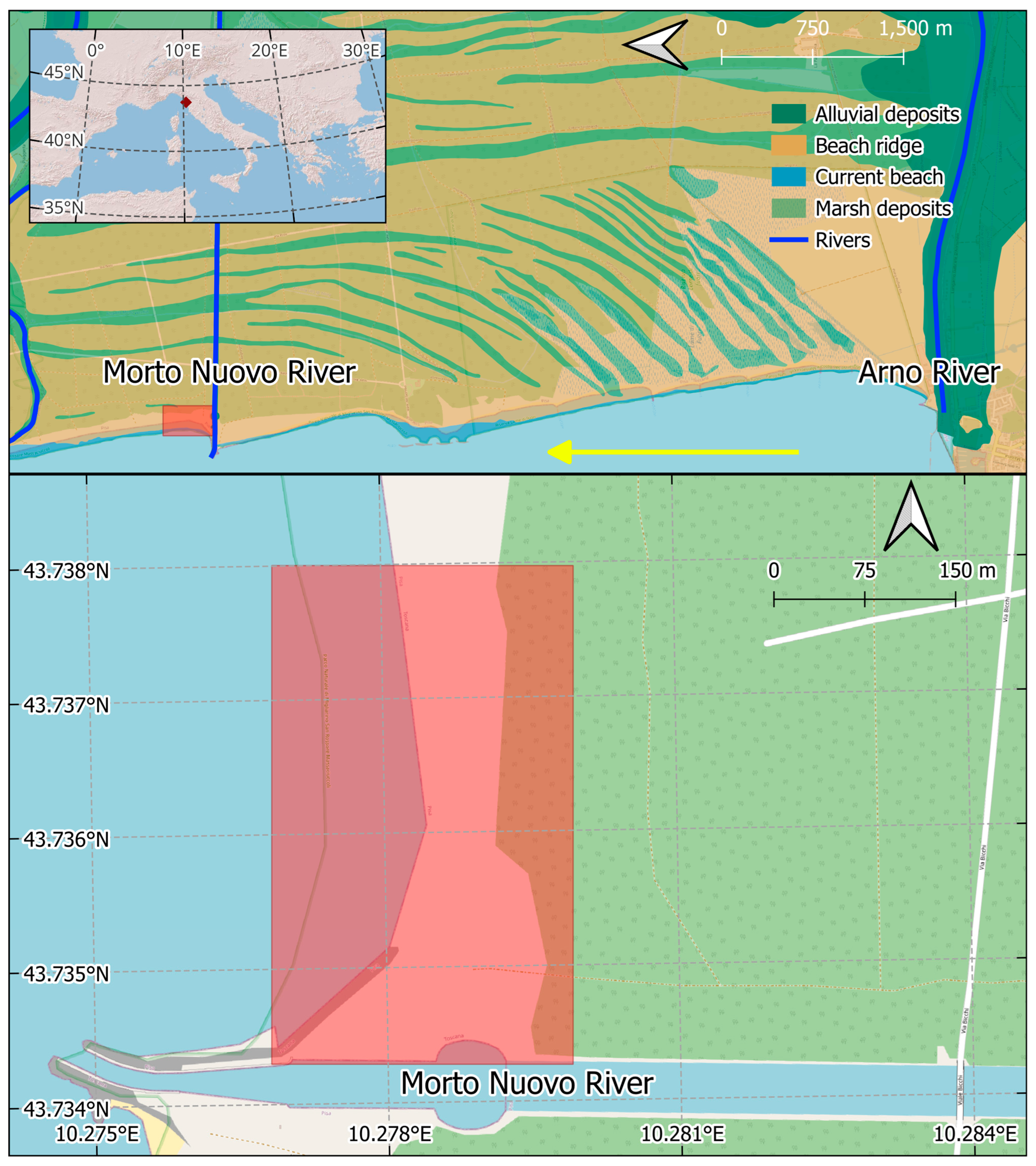

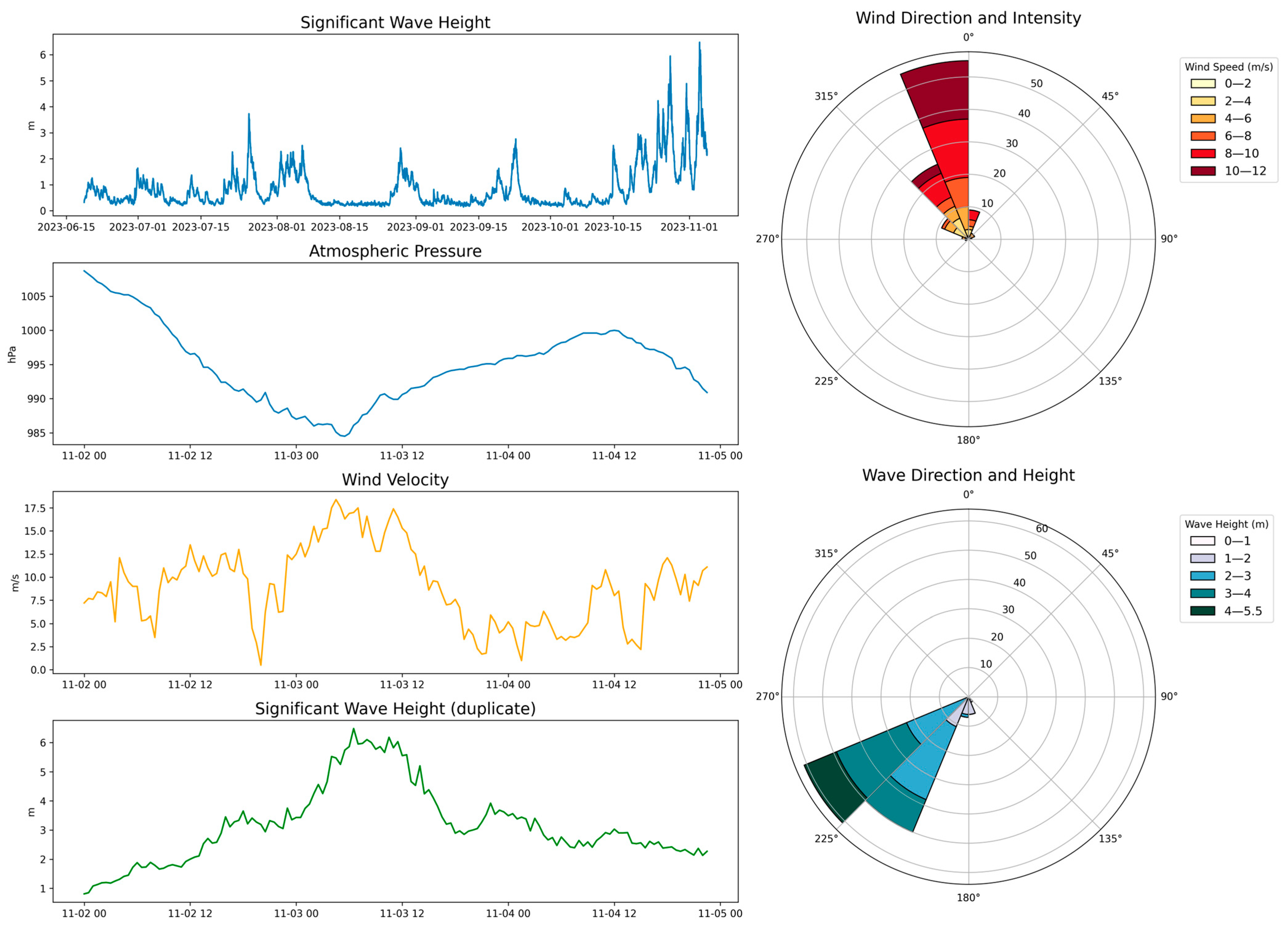
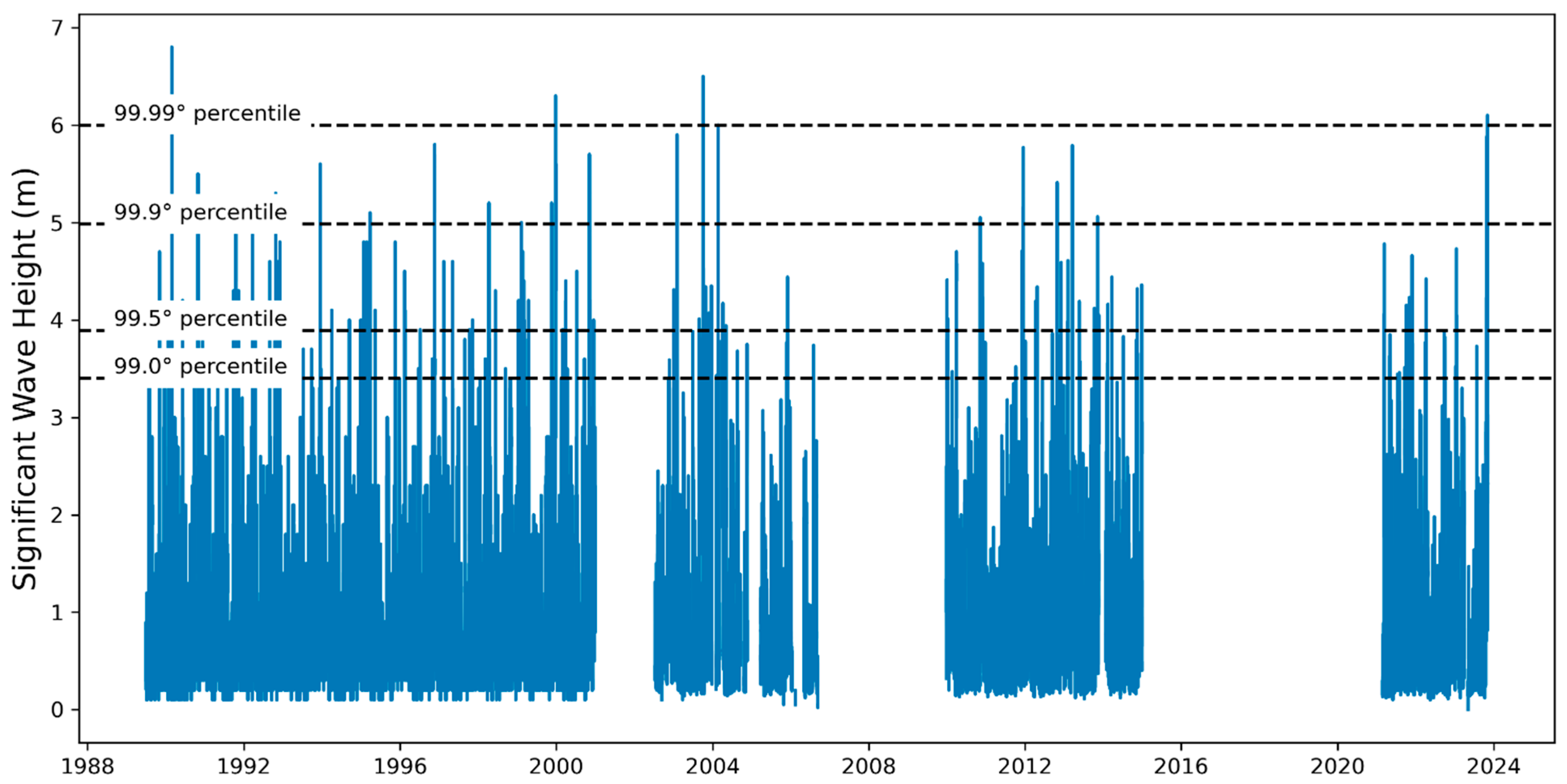

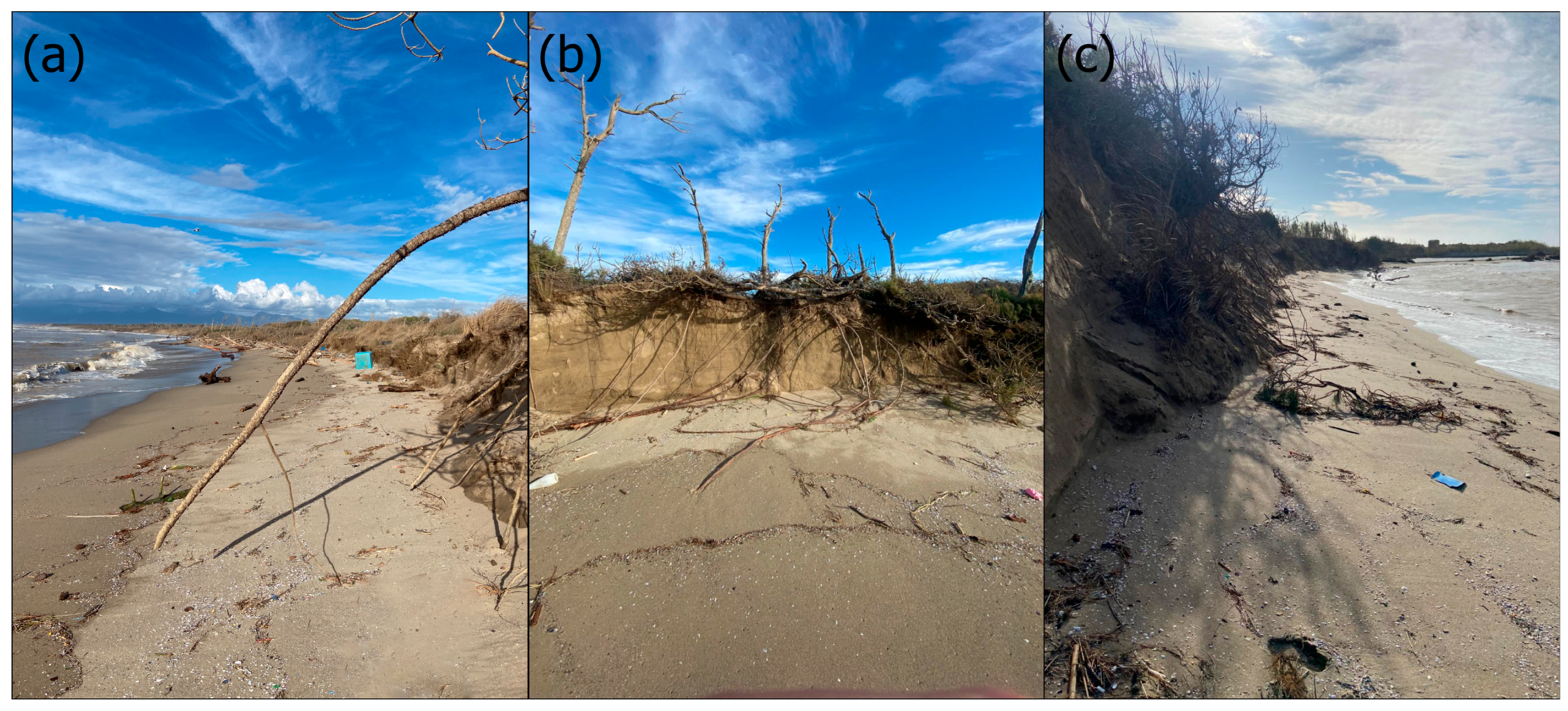

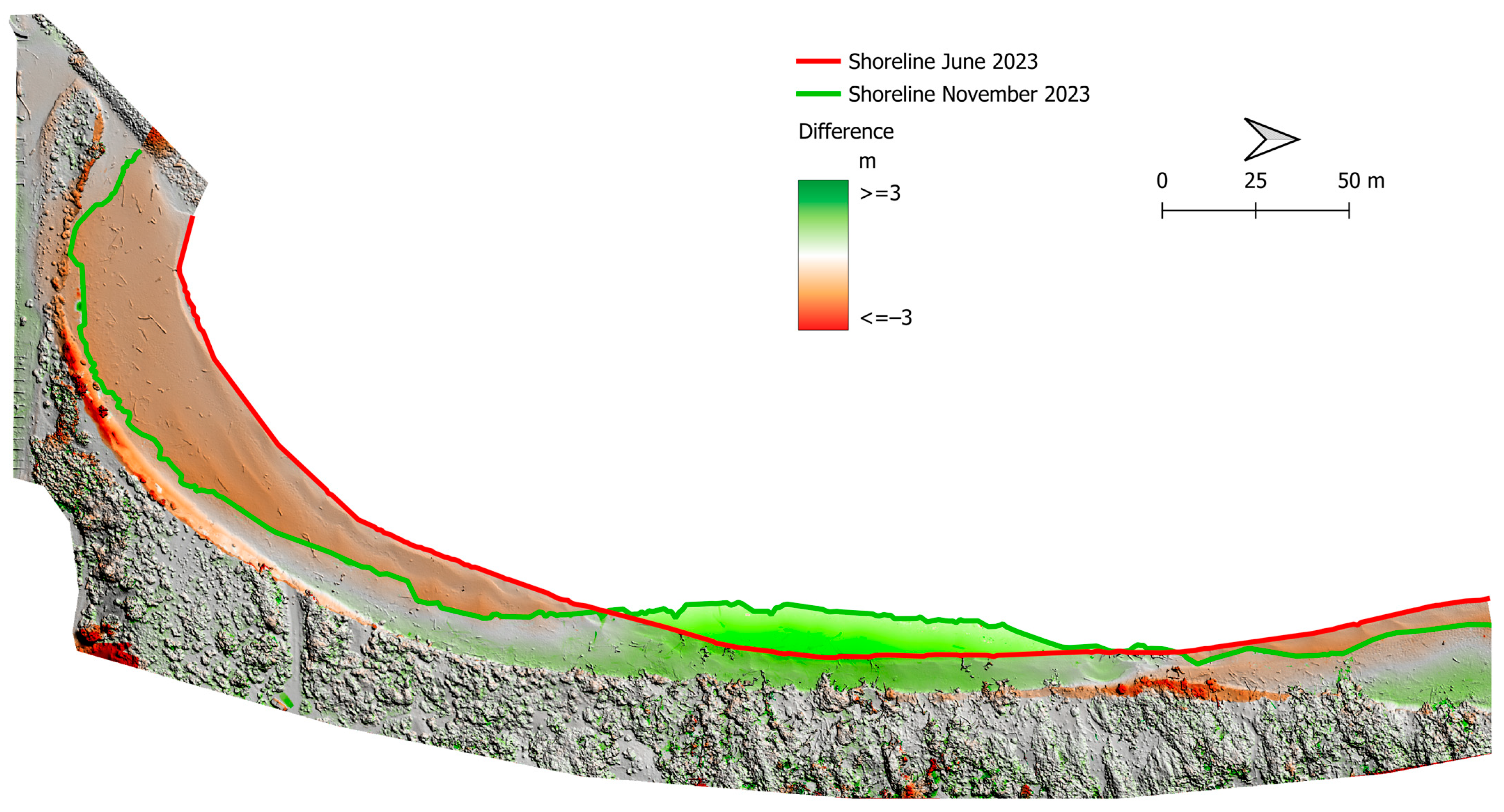

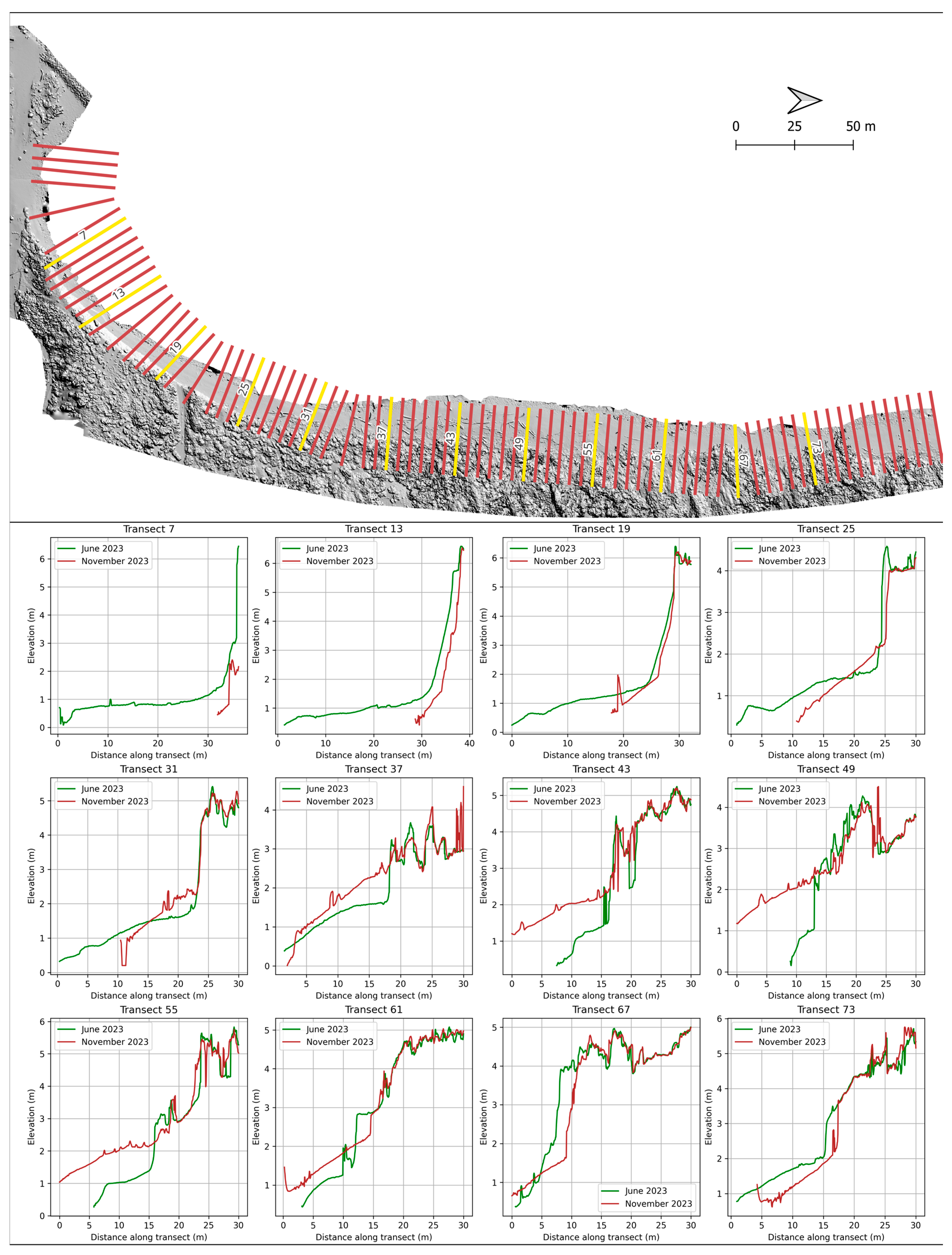
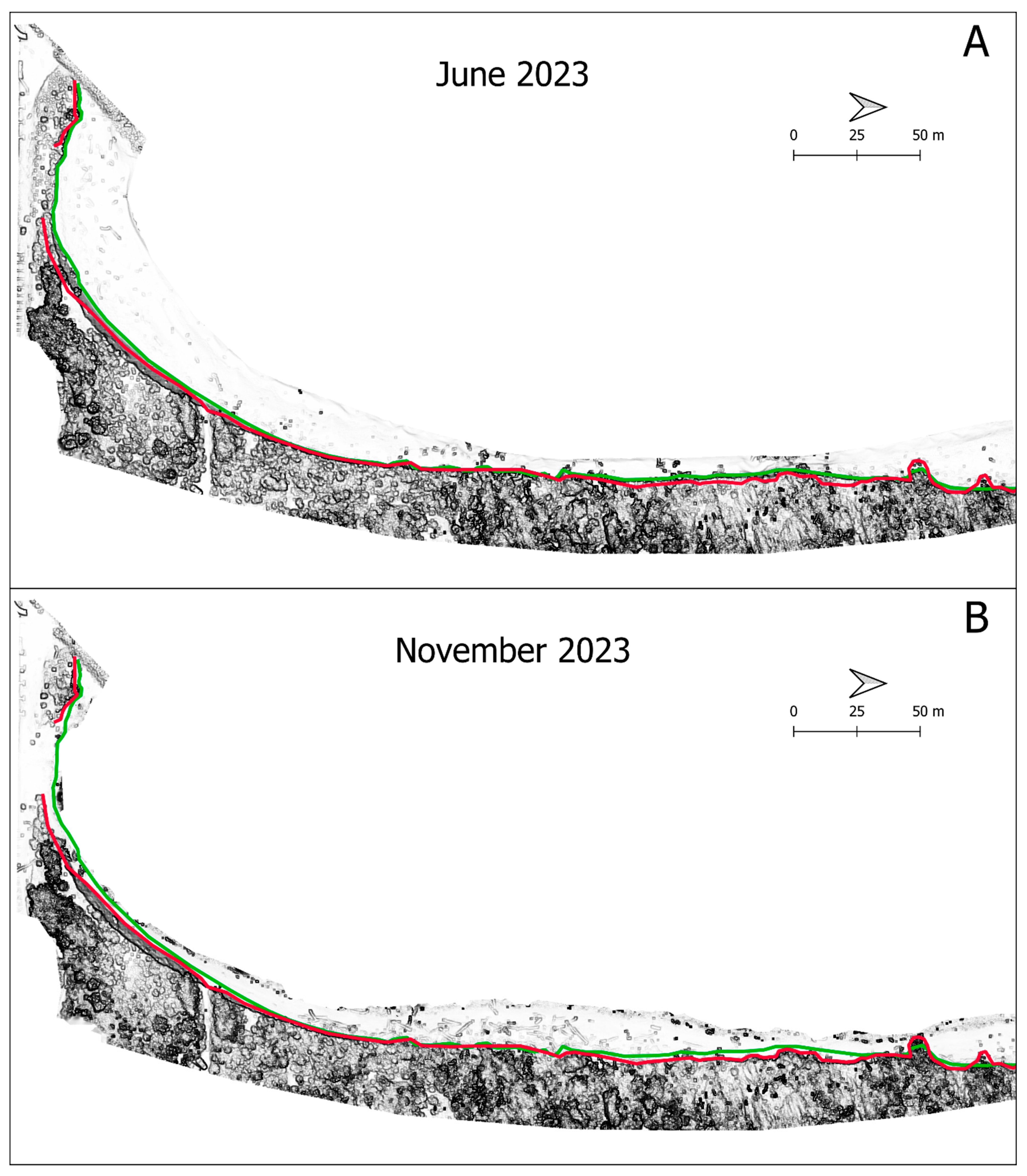
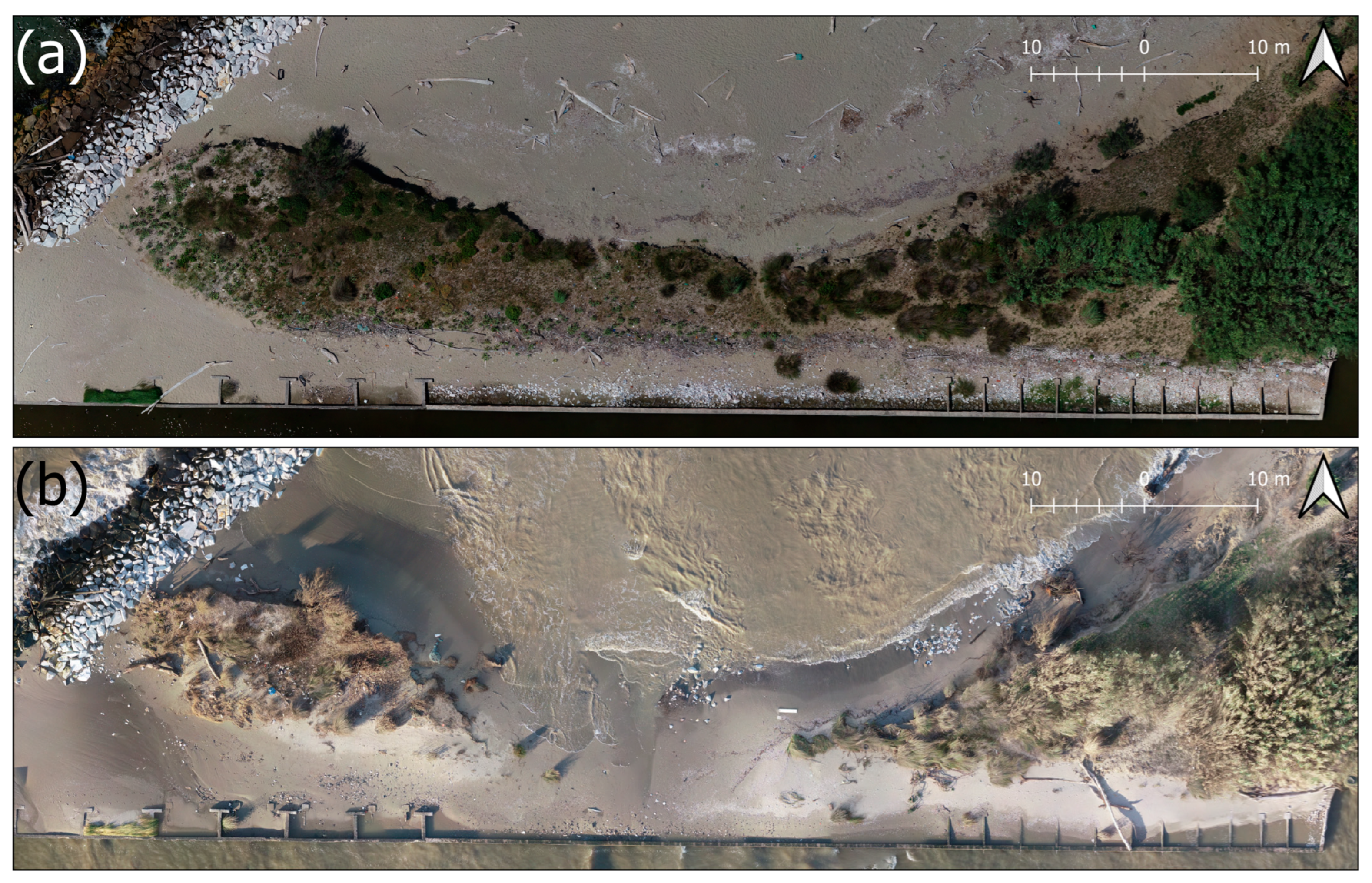
Disclaimer/Publisher’s Note: The statements, opinions and data contained in all publications are solely those of the individual author(s) and contributor(s) and not of MDPI and/or the editor(s). MDPI and/or the editor(s) disclaim responsibility for any injury to people or property resulting from any ideas, methods, instructions or products referred to in the content. |
© 2025 by the author. Licensee MDPI, Basel, Switzerland. This article is an open access article distributed under the terms and conditions of the Creative Commons Attribution (CC BY) license (https://creativecommons.org/licenses/by/4.0/).
Share and Cite
Luppichini, M. Storm-Driven Geomorphological Changes on a Mediterranean Beach: High-Resolution UAV Monitoring and Advanced GIS Analysis. J. Mar. Sci. Eng. 2025, 13, 1568. https://doi.org/10.3390/jmse13081568
Luppichini M. Storm-Driven Geomorphological Changes on a Mediterranean Beach: High-Resolution UAV Monitoring and Advanced GIS Analysis. Journal of Marine Science and Engineering. 2025; 13(8):1568. https://doi.org/10.3390/jmse13081568
Chicago/Turabian StyleLuppichini, Marco. 2025. "Storm-Driven Geomorphological Changes on a Mediterranean Beach: High-Resolution UAV Monitoring and Advanced GIS Analysis" Journal of Marine Science and Engineering 13, no. 8: 1568. https://doi.org/10.3390/jmse13081568
APA StyleLuppichini, M. (2025). Storm-Driven Geomorphological Changes on a Mediterranean Beach: High-Resolution UAV Monitoring and Advanced GIS Analysis. Journal of Marine Science and Engineering, 13(8), 1568. https://doi.org/10.3390/jmse13081568






